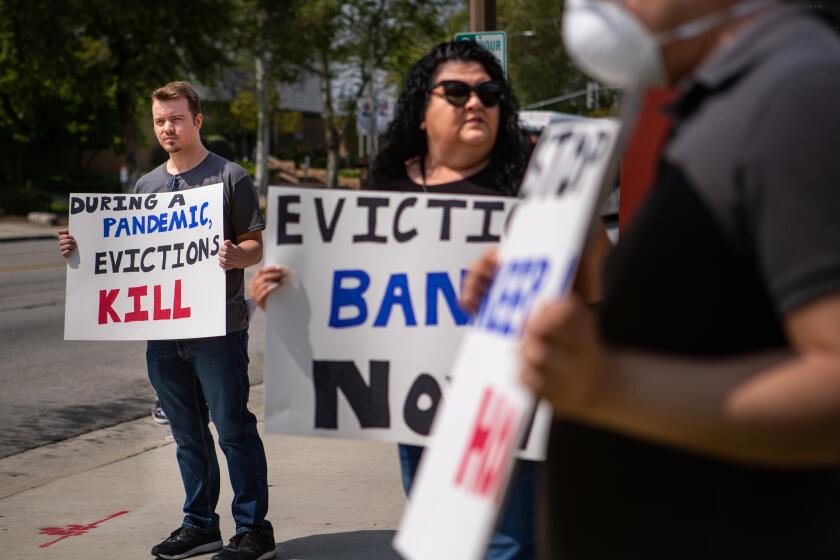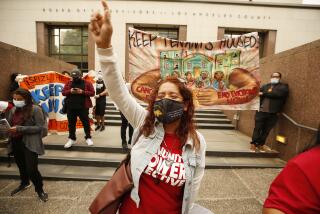Eviction protections are expiring. What does this mean for struggling California tenants?

- Share via
Almost 40 million renters across the country could be at risk of eviction over the next several months as the COVID-19 pandemic continues to ravage the nation’s economy.
In California, tenants have largely been protected so far by a combination of federal, state and local eviction moratoriums and financial assistance programs. But many of those programs are now expiring, leaving millions in jeopardy.
Here’s a guide to how renters are faring and what elected officials may do to assist struggling tenants and landlords.
How are renters doing right now?
The U.S. economy has shed tens of millions of jobs since March and the national unemployment rate remains in the double digits — higher than its peak during the Great Recession. Yet, by some statistics, many tenants have been holding on.
At least 93% of tenants have been paying at least part of their rent monthly during the pandemic, according to the National Multifamily Housing Council, a Washington-based landlord trade group that surveys owners of 11.4 million apartments, or about a quarter of the nation’s rental market. Those figures are only a few percentage points behind what renters paid from April through July in 2019, according to the survey.
In weeks, as many as 1 million families across California may be at risk of being forced out of their homes, pushed off the ‘eviction cliff.’
In California, more than 84% of adults living in rental homes reported paying their rent in the previous month in a U.S. Census Bureau survey conducted July 16-21.
To be sure, certain groups have faced major financial hardships that have affected their ability to stay current on housing payments. People living in the country illegally cannot receive unemployment benefits, for instance, and in California more than 1 million jobless workers still have their claims backlogged in the state’s unemployment system.
Many government assistance programs helping tenants have gone away or are about to
In March, Congress passed an expansion to unemployment benefits, giving those who have lost their jobs an additional $600 a week on top of regular state unemployment payments. Housing advocates and researchers credit that money with helping to keep tenants afloat.
But the expanded unemployment benefits expired at the end of July. So did a limited federal eviction moratorium that covered tenants living in apartments whose landlords have mortgages backed by the federal government.
In California, nearly all evictions have been on hold because the state court system is not processing cases except for those deemed urgent. But state Supreme Court Chief Justice Tani Cantil-Sakauye has said she plans to lift those restrictions as early as Aug. 14, arguing that it’s the job of the governor and state Legislature to mandate any eviction protections.
Just this week, the L.A. County Sheriff’s Department resumed processing eviction cases that had been approved prior to the March government stay-at-home orders, a move that follows similar decisions by other Southern California sheriff’s departments.
Now that these protections are expiring, what’s the risk to tenants and landlords?
One word: immense.
The estimate of as many as 40 million people in America at risk of eviction comes from a new study by the Aspen Institute, a Washington-based think tank, and a group of housing advocates and academics. The study takes into account massive job losses among renter households, U.S. Census Bureau surveys of tenants’ ability to pay and the crushing housing cost burdens faced by renters prior to the pandemic. In California, between 4.1 million and 5.4 million renters could be facing eviction, the study concludes.
“You’re talking about a Great Depression level of suffering,” said Zach Neumann, a senior project manager at the Aspen Institute and a coauthor of the study. “That’s scary. It’s something we haven’t seen in our lifetime.”
Those evictions also are likely to disproportionately affect Black, Latino and other nonwhite Californians. About three-quarters of nearly 1 million renter households affected by coronavirus-related job losses in the state include at least one Black, Latino, Asian or other person of color, according to a new estimate by UC Berkeley’s Terner Center for Housing Innovation.
From the beginning of the pandemic, landlord groups have encouraged their members to refrain from raising rents, work out repayment plans with affected tenants and waive late payment fees among other forms of financial relief.
“It would not be to our benefit to see a whole host of evictions,” said Deb Carlton, executive vice president with the California Apartment Assn. “It’s not good for anybody.”
Some landlords, especially those who own few properties, are facing financial hardships of their own. A recent survey of the National Assn. of Hispanic Real Estate Professionals found that more than half of owners and managers had at least one tenant who hadn’t paid rent in the previous month.
In its initial coronavirus relief plan, Congress allowed many landlords to defer their mortgage payments. But those bills will eventually come due. Landlords can hold on to their properties for only so long without rental income, Carlton said.
“If reporters want to say there’s a wave of evictions coming, they should also say there’s a wave of foreclosures coming,” she said.
What is happening with more relief programs?
While House Democrats and the Trump administration are negotiating further coronavirus-related financial help, there is no deal yet.
In May, the Democrat-controlled House of Representatives passed legislation that would continue the extra $600 a month in unemployment benefits and the limited federal eviction moratorium as well as add $100 billion for rental assistance programs. The Senate, which has a Republican majority, has not taken up the bill. Trump administration officials have said they are interested in continuing expanded unemployment benefits, though at amounts lower than $600 a week, as well as implementing some eviction protections.
At the state Capitol, Gov. Gavin Newsom and legislators say they’re trying to figure out a plan.
“We deeply recognize people’s anxiety,” Newsom told reporters on Monday. “We deeply recognize what’s at stake.”
Legislative leaders have asked Cantil-Sakauye to hold off on allowing courts to process cases until after the Legislature recesses for the year at the end of August.
Currently, there are two pending bills that would halt evictions during the pandemic and give tenants more time to repay overdue rent. One, Assembly Bill 1436, would bar landlords from evicting tenants over coronavirus-related missed rent, and it aims to provide property owners mortgage relief. The second, Senate Bill 1410, would provide tax breaks to landlords if their tenants cannot pay. Both bills could have committee hearings next week.
If the federal and state governments don’t act, what’s left?
Roughly a quarter of local governments in California have passed some sort of eviction protections during the pandemic, though some have already expired, according to a list compiled by the California Apartment Assn. The protections vary widely, and many could require tenants to go to court to remain in their homes.
That’s the situation in the city of Los Angeles. Landlords are not allowed to remove tenants who have lost income due to the pandemic, but they can still file eviction cases and renters would have to prove they qualify for relief at trial. The vast majority of tenants in eviction cases aren’t represented by attorneys, and renter advocates worry that the city’s protections are insufficient.
The city’s rules also say that affected tenants have a year after the expiration of the state of emergency to repay past due rent. That provision frustrates landlords who won’t be able to enforce collecting rent payments from this spring at least until well into 2021.
Additionally, the city is handing out $100 million in rental assistance funds to low-income Angelenos, but it’s not nearly enough to meet the need. The city received more than 221,000 applications for the program, but expects to be able to help only 50,000 households.
Times staff writers Melody Gutierrez, Phil Willon and Sarah D. Wire contributed to this report.
More to Read
Sign up for Essential California
The most important California stories and recommendations in your inbox every morning.
You may occasionally receive promotional content from the Los Angeles Times.








